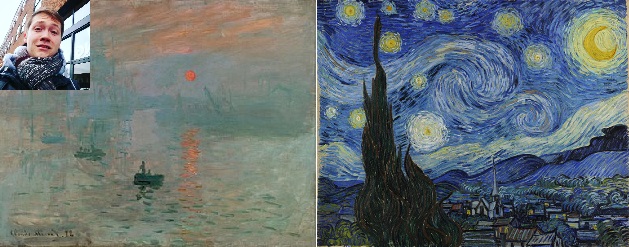Vincent Van Gogh Wasn’t Actually An Impressionist Painter

See, “The Impressionist Movement” was an artistic movement during the 18th century that aimed to create paintings that would seem very realistic at a glance, but more abstract when viewers took a closer look. This was achieved by capturing very realistic depictions of light and its movement, without portraying solid and defined forms. Because color and light go hand in hand, this meant that Impressionists had to create very realistic color palettes when painting, in order to simulate the way light appeared in the real world.
Most of us already know that Impressionism wasn’t initially well received. Despite the impressive use of color to create fluid and changing forms, Impressionist art was looked down upon as seeming juvenile and too non-conventional to be appreciated as “real” art. In fact, the movement started getting referred to as “Impressionism” when an art critic named Louis Leroy used the word to criticize a painter named Claude Monet, and his painting “Impression of a Sunrise”—which today is often credited as one of the most important pieces in history for setting a huge precedent in the world of artists making “non-conventional” works of art.
Which brings us to Vincent Van Gogh.
Today, Vincent Van Gogh is one of the most popular artists of all time, amongst artists and the “average Joe” alike. Van Gogh’s work, which was even less popular than Monet’s at the time, was actually part of a movement called “Post-Impressionism,” which began shortly after the Impressionist movement started to take off.
While the Impressionists prided themselves on realistic and meticulous use of color, Post Impressionists saw the opportunity to use color far more expressively and symbolically. They maintained many of the same painterly brush strokes and techniques of the Impressionist painters, but valued color palettes that were bold, striking, and not as natural as the ones used by Impressionists. They believed that this daring use of color could be used to convey a sense of mood and atmosphere more effectively than a realistic or natural one.
Long story short: Impressionists like Claude Monet used expressive techniques and realistic colors to create a lifelike impression of what the eye sees in the real world. A Post-Impressionist like Vincent Van Gogh, however, used expressive painting techniques and vivid, dramatic colors to create an impression of what the heart feels.
In the history of art, both movements are incredibly important. They pushed the boundaries of what artists could do, and what the public accepted as interesting and impressive artwork. This defiance of conventional artistic practices led to a domino effect of rapidly changing artistic movements that have brought us to a modern world filled with many different kinds of artists, all freely expressing their creative vision through a multitude of styles and practices.
If you want to experience Post-Impressionist painting for yourself, pay some appreciation to Vincent Van Gough, or just enjoy a fun night out with your friends, you can sign up for our “Simply a Starry Night” class on March 9th—where we’ll teach you how to paint your own version of Van Gogh’s famous “Starry Night” painting.
And for the record: that story about Van Gogh cutting off his own ear might not be entirely true either. There are a lot of different accounts of what exactly happened to Van Gogh’s ear, and according to journalist Christel Kucharz, of ABCNews, Van Gough and another artist, Paul Gauguin, made a pact together that they would never reveal exactly what became of the ear. (For more on that you can read Kucharz's artical by following the link below)
- The Artist's Insight - A monthly blog special by Eric Maille -
I’ve been painting my entire life, but I think you’ll agree with me that being a painter doesn’t make you an artist. An artist must be willing to explore the fascinating world that exists behind paintings- a rich history of unique talents, creative imaginations, innovative techniques, and thoughtful self-expression.
I’ve spent a long time developing that insight and learning from the insight of others, and it's helped me to become a professional painter and illustrator living and working in Norman Oklahoma, and an instructor at Pinot’s Palette Bricktown. Now, once a month, I’ll be providing tips, tricks, and stories from a polished perspective, and an artist’s insight, so that even the casual painter, can become an art-lover and artist themselves!
Sincerely yours, Eric Maille
Share Paint your own Van Gogh Starry Night! | Read Kucharz's Artical

